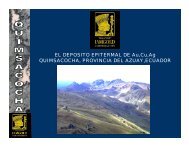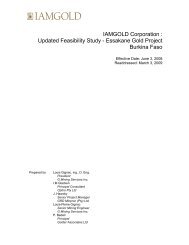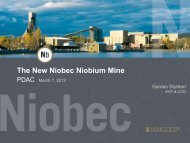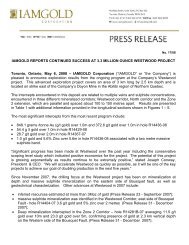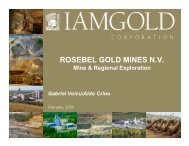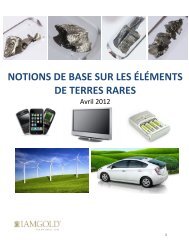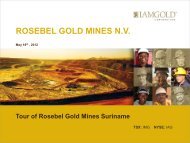NI 43-101 Technical report, Surface diamond drilling ... - Iamgold
NI 43-101 Technical report, Surface diamond drilling ... - Iamgold
NI 43-101 Technical report, Surface diamond drilling ... - Iamgold
You also want an ePaper? Increase the reach of your titles
YUMPU automatically turns print PDFs into web optimized ePapers that Google loves.
R a r e E a r t h E l e m e n t E x p l o r a t i o n P r o g r a m M a r c h - 2 0 1 3<br />
W i n t e r - S u m m e r 2 0 1 2 P a g e | 21<br />
Beside these ring-dykes and cone-sheets, numerous calcitic and dolomitic dykes, cogenetic to<br />
the dolomitite and calcitite cone-sheets, have been cross-cut by Soquem drill holes (Fortin,<br />
1977).<br />
Regarding the dip of these different ring-dykes and cones-sheets constituting this carbonatite<br />
complex, besides the shallow exploration drill holes data of Soquem interpreted with a 70°<br />
dipping structures (Vallée and al., 1969), mine drill holes data (surface and underground),<br />
show to a depth of 800m, a sub-vertical to 70° dipping to the north of the Mine carbonatite<br />
structures (C5 and C3).<br />
Considering the concentric structure of this carbonatite complex, a conical geometry with a<br />
strong dip of the different units toward the center of the cones remains the more probable<br />
scheme for this carbonatite complex.<br />
A northwest-southeast schematic geological cross section has been established, to better<br />
visualize and understand the spatial internal organization of the St-Honoré carbonatite<br />
complex (Figure 6).<br />
9.2.1.3 The Carbonatite complex Zoning<br />
Following the petro-geochemical study of the carbonatite complex (Fortin, 1977), zoning<br />
seems to manifest itself between the different facies units of the carbonatite regarding their<br />
geochemical composition and their chronology:<br />
• The carbonatite complex has a reniform shape consisting of a central portion of<br />
carbonatic rocks enclosed in an alkaline syenite;<br />
• The age of the different units of the syenite show a chronologic evolution in the<br />
following magmatic suite from ”Ijolite-Urtite-Foidite (to) syenite-Feldspathoidic<br />
syenite (to) Alkali syenite-Lamprophyre-Carbonatite”;<br />
• The age of the different units of carbonates decreasing progressively inwards from<br />
alkali syenite, calcitite through dolomitite to ferro-carbonatite;<br />
• The carbonatite comprises concentric lens which evolved from calcitite through<br />
dolomitite, to a brecciated core of ferrocarbonatite;<br />
• The carbonatite shows an outward inward carbonate evolution expressed<br />
mineralogically by the suite “calcite- dolomite- ankerite-siderite”,<br />
In spite of the similarities with other carbonatite complexes, (1) such as the presence of a<br />
carbonatite core bordered by a syenite in Oka, (2) zonality between calcitite and dolomitite as<br />
in Firesand carbonatite (Superior province, Ontario), the St-Honoré carbonatite complex is<br />
different by the absence of ultramafic rocks as in Oka (Fortin, 1977).<br />
3400, chemin du Columbium, St-Honoré-de-Chicoutimi, QC G0V 1L0 Canada – tel. : 418 673-4694 Fax : 418 673-3179<br />
E-mail : info.niobec@iamgold.com www.niobec.com



